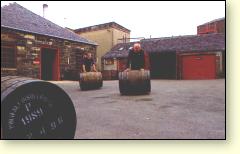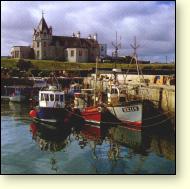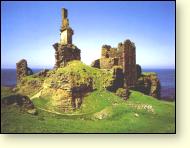
 |
|
Location: Wick, Caithness KW1 5BA
Roads: Huddart Street in Pulteneytown suburb
Hours: Please telephone for information about visits
Phone: 01955-602371
Homepage: www.inverhouse.com
|
Text from The Whisky Trails, Copyright © Gordon Brown 1993:
Wick lies in the far north-eastern corner of Scotland, less than 20 miles from John O’Groats where the land runs out. Wick was a Royal Burgh in the 16th century but it was the 19th-century herring industry based there that brought both notoriety and prosperity. So many fishing craft crammed the bay – often a thousand at a time – that the masts looked like defoliated woodland and people could walk across the great harbour by passing from one boat to the next. So wild was the town that the authorities had to declare prohibition for a time; a dry town with a distillery in full production!
Much of the town is built in the distinctive local Caithness flagstone, the structure of which may be seen on the coast road as the littoral rises to run along the clifftop. Dramatically sited castle ruins are scattered about, Wick, Sinclair and Girnigoe being among the best known. Pultneytown on the southern side of the harbour was built by Thomas Telford as a planned fishing village and the streets were named after his own friends. It was later improved by the engineer Thomas Stevenson, and his famous son, Robert Louis, author of Treasure Island, lived with him in the town while the work was carried out.

The most mortherly town of mainland Scotlant, John O'Groats is less than 20 miles north of the Pultney Distillery. Famous for its position, John O'Groats has a small fishing industry. However, you will have to travel on to Thurso to get a ferry to Orkney-
|
Like Oban and only one or two other distilleries, Pulteney is in a town setting. It is the northernmost distillery on the mainland (two more, remember, on Orkney) and was established in 1826 by James Henderson, already a seasoned distiller with 30 years’ (probably illicit) experience further inland. Pulteney remained in the family’s hands for almost a century and bottles of their Henderson brand of whisky are displayed at the distillery. A decade after it was sold Pulteney closed and did not reopen for 21 years when it was bought by R. Cumming, the Banff lawyer who had also bought Balblair. He in turn sold on to Hiram Walker, who rebuilt the distillery in 1959. It was sold to Inver House in 1995.
The water used for cooling the distillation is run from Loch Hempriggs in a lade designed by Thomas Telford. Although Victorian in date, much of the distinctive structural appearance of a distillery of its time has disappeared. The maltings were taken out of use in 1959. Two stills are in place now but at the turn of the century there were three. The two very small spirit stills in use then were subsequently removed and a single large unit installed to take their place. Both of the present stills are distinctively, rather oddly shaped, but since they produce the Pulteney signature in the spirit, the dimensions will never be changed; replacements will always be exact copies. Mostly bourbon casks are used to mature Pulteney spirit and the warehouses on site can accommodate about 30,000 of them.
The Whisky
Text from The Whisky Trails, Copyright © Gordon Brown 1993:

High on a headland, the spectacular castles of Sinclair and Girnigoe are just a few miles from the centre of Wick.
|
Pulteney is yet another coastal whisky, with an earthy, pungent character, although it shares the lightness and smoky cleanness of Clynelish and Brora rather than the simmering concentration of Skye and Islay. Indeed it is sometimes described as the ‘Manzanilla of the North’, referring to the tangy, salty style created when certain sherries are matured on the Mediterranean coast near Jerez in southern Spain. Pulteney is bottled at a younger age than most malts - eight years at 40% vol. – due to its reputation for rapid maturation. Further choice is available from the independents – 12-, 15- and 22-year-old, as well as 1961 vintage, being recently on offer and sometimes described as Old Pulteney. The distillery’s whisky is one of the malts used in the make-up of Ballantine’s blended brands.
Source of water
Loch of Hempriggs
Of interest
Text from The Whisky Trails, Copyright © Gordon Brown 1993:
• Wick Heritage Centre has a kippering kiln, a cooperage and a blacksmith’s shop in its absorbing evocation of the town’s rich past. There is also a remarkable photographic collection, with over 100,000 glass negatives of Victorian Wick.
• Caithness Glass welcomes visitors to watch hand-blown glass production in its workshops near the airport.
• Castles pepper the country around Wick, many of them wonderfully atmospheric ruins in spectacular clifftop settings like Sinclair and Girnigoe. Others have become comfortable hotels like Ackergill Tower where television personality Philip Schofield had his wedding reception.